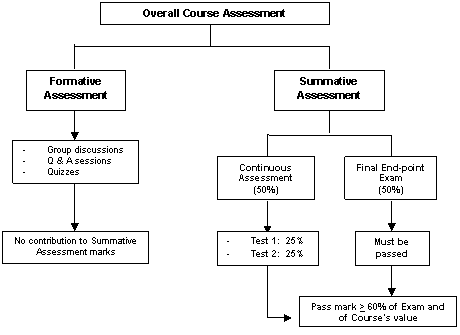ASSESSMENT
Formative Assessment
Formative Assessment is useful to students and instructors, both.
Students may receive their work back, in Formative Assessment, with comments, suggestions and, sometimes, a “formative mark”: this helps students to monitor how well they do progress in the course and to identify areas or topics that require greater effort or attention.
Formative Assessment provides instructors with an understanding of what students know (and don’t know) in order to adapt teaching and learning to meet students’ needs, while the course is still in progress.
Formative Assessment can consist of group discussions, presentations, written essays, portfolios, question and answer sessions, trial examination papers and tests. Whatever form they may take, Formative Assessment is done intermittently throughout the course. These activities are not graded and therefore do not contribute to the overall course assessment. However, students are encouraged to take part in these activities for the purpose of self-evaluation, especially to gauge their own level of understanding and their progress. It is also an exercise to identify and iron out any “grey areas” with the course instructor. (What is a “grey area”? Is it a subject, topic or specific joint about which a student is act completely clear or satisfied, and wished to receive some clarification or additional information?).
Summative Assessment
The goal of Summative Assessment is to measure achievement or failure of students’ knowledge and skills with respect to the intended learning outcomes of the course.
Summative Assessments is divided into Continuous Assessment and end-point Examination.
- Continuous Assessment: in the forms of tests, quizzes, assignments, projects, etc. that are done during the course
- End-point Examination: a final, formal written exam paper administered at the end of the course. The exam paper will focus on the all broader themes/ topics of the course, and test the degree of integrated understanding that the student has gained in all the topics of the course.
For each course, Continuous Assessment and final Examination contribute, normally, by 50% each to the Summative Assessment, which is computed as 100% the value of each course.
IMPORTANT NOTE: for all PHTP courses, the course passing mark is 60% of the total Summative Assessment value, expressed as 100%; however, the final Examination must also be passed.
A sample outline of the overall assessment for PHTP courses

- The work submitted was done in part or whole by an individual other than the one submitting or present the work.
- The whole work or parts of it are copied from another source without due reference.
- A student submits, in one course, work which has already been submitted in another course, without prior arrangement with both course instructors.
Grading system
Grade |
Percentage |
Outcome |
A |
90-100% |
Superior |
B |
80-89% |
Above Average |
C |
70-79% |
Average |
D |
60-69% |
Passing |
F |
Below 60% |
Failure |